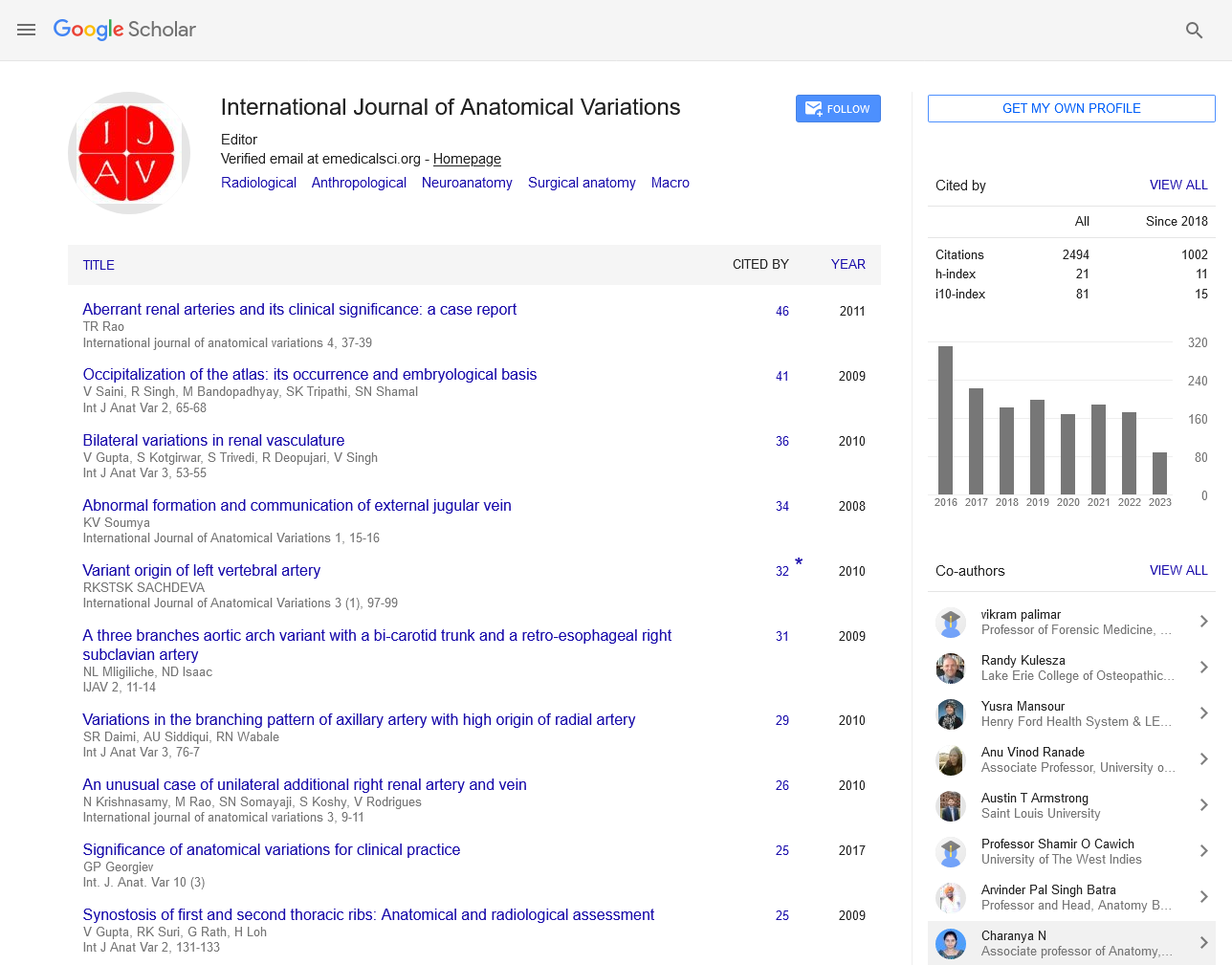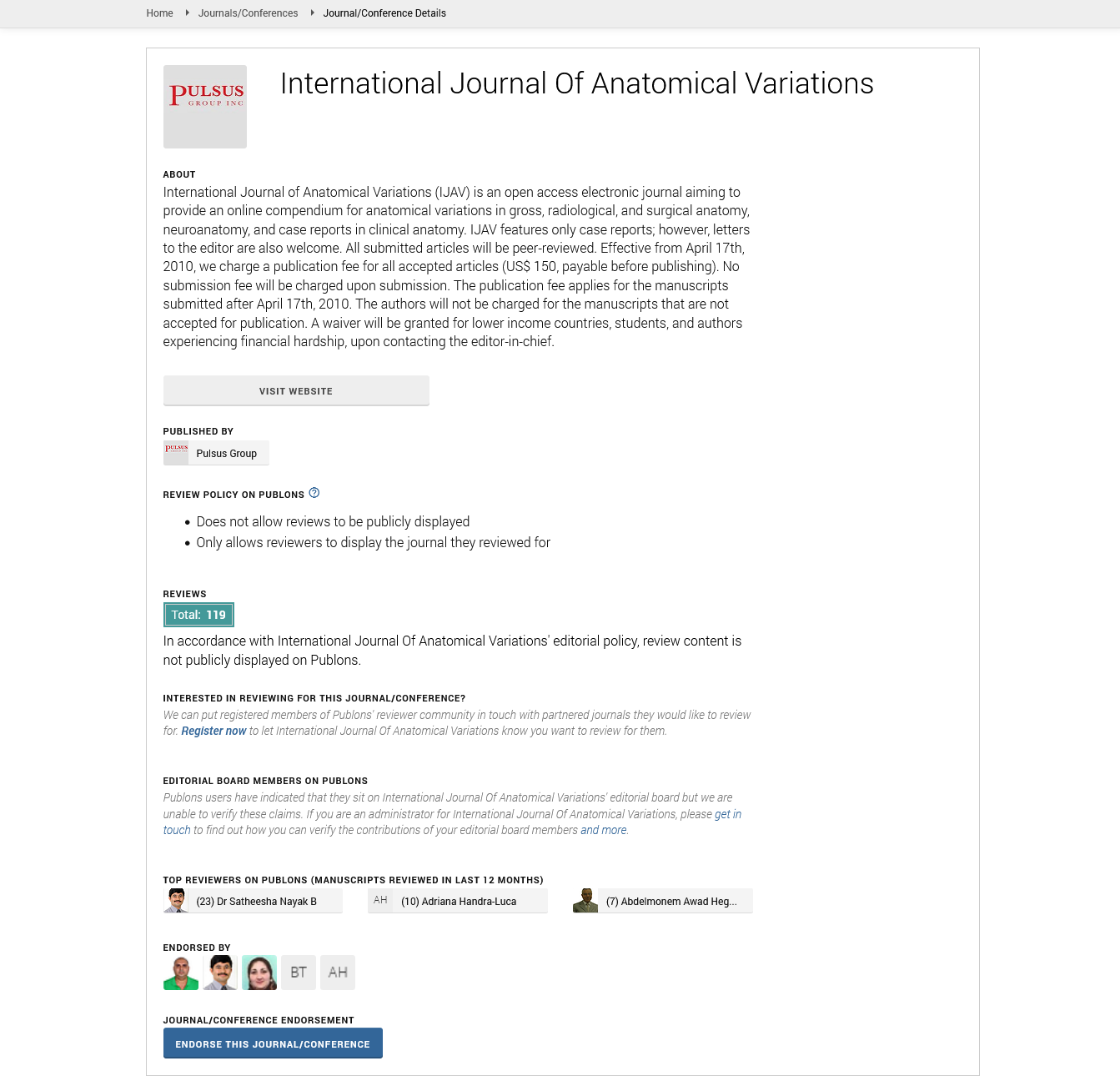The Interplay of Functional Anatomy and Physical Therapy: A Synergistic Approach
Received: 03-Sep-2024, Manuscript No. ijav-24-7305; Editor assigned: 05-Sep-2024, Pre QC No. ijav-24-7305; Reviewed: 19-Sep-2024 QC No. ijav-24-7305; Revised: 24-Sep-2024, Manuscript No. ijav-24-7305; Published: 30-Sep-2024, DOI: 10.37532/1308-4038.17(9).440
This open-access article is distributed under the terms of the Creative Commons Attribution Non-Commercial License (CC BY-NC) (http://creativecommons.org/licenses/by-nc/4.0/), which permits reuse, distribution and reproduction of the article, provided that the original work is properly cited and the reuse is restricted to noncommercial purposes. For commercial reuse, contact reprints@pulsus.com
Abstract
This article explores the synergistic relationship between functional anatomy and physical therapy, highlighting how an understanding of anatomical structures and their functions can enhance therapeutic practices. The intricate interplay between muscles, joints, and connective tissues plays a pivotal role in movement and stability, directly influencing rehabilitation outcomes. By integrating functional anatomy into physical therapy protocols, practitioners can tailor interventions to individual patient needs, promoting more effective recovery strategies. This approach not only improves patient education and engagement but also fosters a holistic understanding of bodily mechanics, empowering patients to participate actively in their rehabilitation. Case studies demonstrating successful applications of this synergy in diverse patient populations will be discussed, underscoring the importance of this interdisciplinary collaboration in optimizing therapeutic outcomes. Ultimately, the article advocates for a more integrated curriculum in physical therapy education that emphasizes functional anatomy as a cornerstone of effective practice.
INTRODUCTION
The practice of physical therapy has evolved significantly over the years, embracing a more holistic and integrative approach to patient care. Central to this evolution is the profound understanding of functional anatomy—the study of the structure and organization of the body in relation to its function. Functional anatomy serves as the foundation upon which physical therapy interventions are built, guiding therapists in their assessment and treatment of musculoskeletal disorders [1].
As the human body is a complex system of interconnected muscles, bones, and tissues, a thorough knowledge of these components is essential for effective diagnosis and rehabilitation. This knowledge allows physical therapists to identify dysfunctions in movement patterns and apply targeted therapeutic strategies that enhance recovery. Furthermore, an understanding of functional anatomy fosters a deeper appreciation of how various body systems work together, allowing for a more comprehensive approach to treatment that considers not just the injured area, but the entire body [2].
This paper explores the synergistic relationship between functional anatomy and physical therapy, emphasizing how integrating these disciplines can optimize therapeutic outcomes. It will discuss the relevance of functional anatomy in formulating individualized treatment plans, improving patient engagement, and facilitating a deeper understanding of rehabilitation processes. Through an examination of case studies and contemporary research, this article aims to illustrate the practical benefits of this integrated approach, advocating for its adoption in physical therapy education and practice. By embracing the interplay between functional anatomy and physical therapy, practitioners can enhance their effectiveness and contribute to improved patient health and well-being [3].
DISCUSSION
The integration of functional anatomy into physical therapy practice offers numerous benefits that can significantly enhance patient outcomes. This synergy is particularly evident in the personalized treatment plans that emerge from a thorough understanding of each patient's anatomical and functional profile. By recognizing the unique anatomical variations and movement patterns of individuals, physical therapists can develop tailored interventions that address specific dysfunctions, leading to more effective rehabilitation [4].
One of the key advantages of this synergistic approach is the ability to improve assessment accuracy. Traditional evaluation methods may overlook subtle anatomical factors contributing to a patient's condition. However, by applying knowledge of functional anatomy, therapists can identify underlying issues, such as joint instability or muscular imbalances that may not be immediately apparent [5]. This comprehensive assessment allows for targeted interventions that directly address the root causes of pain or dysfunction, rather than merely alleviating symptoms.
Furthermore, the incorporation of functional anatomy into physical therapy enhances patient education and engagement. When therapists explain the anatomical basis for their treatment strategies, patients are more likely to understand the importance of their rehabilitation exercises and adhere to prescribed programs. This educational component empowers patients, fostering a sense of ownership over their recovery process. As patients become more informed about their bodies, they may also be more inclined to make lifestyle changes that support long-term health and injury prevention [6].
Case studies illustrate the tangible benefits of this interdisciplinary approach. For instance, a study examining athletes recovering from knee injuries revealed that those who received therapy informed by functional anatomy showed faster recovery times and a lower rate of re-injury compared to those who underwent conventional treatment. Similarly, patients with chronic pain conditions demonstrated significant improvements in function and quality of life when their rehabilitation included anatomical education alongside therapeutic exercises [7].
Despite the clear advantages, challenges remain in fully integrating functional anatomy into physical therapy practice. One major hurdle is the potential disconnect between educational institutions and clinical settings. While many physical therapy programs emphasize anatomy, there is often limited emphasis on applying this knowledge in a clinical context [8]. Bridging this gap requires ongoing collaboration between educators and practitioners to ensure that curricula are aligned with current best practices.
Additionally, therapists must remain adaptable, recognizing that functional anatomy is not static; it evolves with ongoing research and advancements in our understanding of human movement. Continuous professional development and training opportunities are essential for physical therapists to stay informed about new findings and techniques that can further enhance their practice [9].
In conclusion, the interplay of functional anatomy and physical therapy creates a powerful framework for effective rehabilitation. By fostering a deeper understanding of the body’s structure and function, therapists can improve assessment accuracy, enhance patient education, and deliver personalized treatment strategies. Emphasizing this synergy in both educational and clinical settings will ultimately lead to better patient outcomes and a more holistic approach to rehabilitation. As the field continues to evolve, the integration of functional anatomy into physical therapy should be seen not just as beneficial, but as essential for advancing the practice and improving the health and well-being of patients [10].
CONCLUSION
The interplay between functional anatomy and physical therapy represents a crucial advancement in the way rehabilitation is approached and delivered. By integrating a comprehensive understanding of anatomical structures and their functions into therapeutic practices, physical therapists can create individualized treatment plans that address not only the symptoms of injury or dysfunction but also their underlying causes. This synergy enhances assessment accuracy, empowers patients through education, and fosters a collaborative rehabilitation experience that promotes adherence and active participation.
As demonstrated through case studies and evidence-based practices, this integrated approach has the potential to yield significant improvements in patient outcomes, including faster recovery times and reduced re-injury rates. However, to fully realize these benefits, it is essential to bridge the gap between educational training and clinical application. Ongoing professional development, interdisciplinary collaboration, and a commitment to adapting to new research findings are vital for physical therapists to remain at the forefront of effective rehabilitation practices.
In summary, embracing the synergy between functional anatomy and physical therapy is not just advantageous; it is imperative for the evolution of the field. By prioritizing this integration in both educational curricula and clinical settings, we can enhance the quality of care provided to patients, ultimately leading to improved health outcomes and a more profound understanding of the human body’s potential for recovery and resilience.
REFERENCES
- Osher M, Semaan D, Osher D. The uterine arteries, anatomic variation and the implications pertaining to uterine artery embolization. J Vasc Interv Radiol 2014; 25:S143.
- Park K-M, Yang S-S, Kim Y-W, Park KB, Park HS, et al. Clinical outcomes after internal iliac artery embolization prior to endovascular aortic aneurysm repair. Surg Today 2014; 44:472-477.
- Patel SD, Perera A, Law N, Mandumula S. A novel approach to the management of a ruptured Type II endoleak following endovascular repair of an internal iliac artery aneurysm. Br J Radiol. 2011; 84(1008):e240-2.
- Szymczak M, Krupa P, Oszkinis G, Majchrzycki M. Gait pattern in patients with peripheral artery disease. BMC Geriatrics. 2018; 18:52.
- Rayt HS, Bown MJ, Lambert KV. Buttock claudication and erectile dysfunction after internal iliac artery embolization in patients prior to endovascular aortic aneurysm repair. Cardiovasc Intervent Radiol. 2008; 31(4):728-34.
- Fontana F, Coppola A, Ferrario L. Internal Iliac Artery Embolization within EVAR Procedure: Safety, Feasibility, and Outcome. J Clin Med. 2022; 11(24):73-99.
- Bleich AT, Rahn DD, Wieslander CK, Wai CY, Roshanravan SM, et al. Posterior division of the internal iliac artery: Anatomic variations and clinical applications. Am J Obstet Gynecol. 2007; 197:658.e651-658.e655.
- Chase J. Variation in the Branching Pattern of the Internal Iliac Artery. In: University of North Texas Health Science Center. Fort Worth. 2016: 1-33.
- Nayak SB, Shetty P, Surendran S, Shetty SD. Duplication of Inferior Gluteal Artery and Course of Superior Gluteal Artery Through the Lumbosacral Trunk. OJHAS. 2017; 16.
- Albulescu D, Constantin C, Constantin C. Uterine artery emerging variants - angiographic aspects. Current Health Sciences Journal 2014; 40:214-216.
Indexed at, Google Scholar, Crossref
Indexed at, Google Scholar, Crossref
Indexed at, Google Scholar, Crossref
Indexed at, Google Scholar, Crossref
Indexed at, Google Scholar, Crossref
Indexed at, Google Scholar, Crossref
Indexed at, Google Scholar, Crossref






